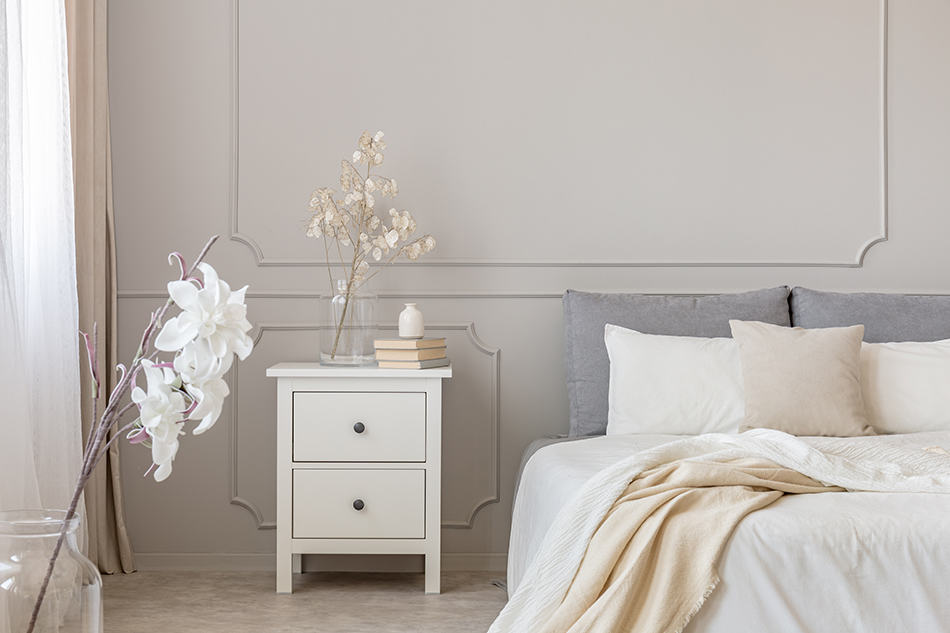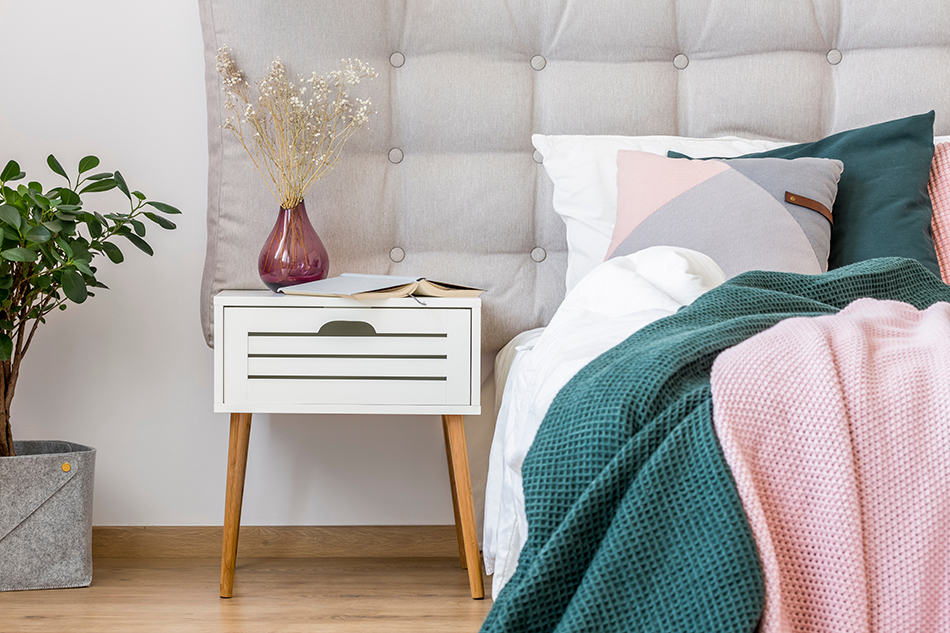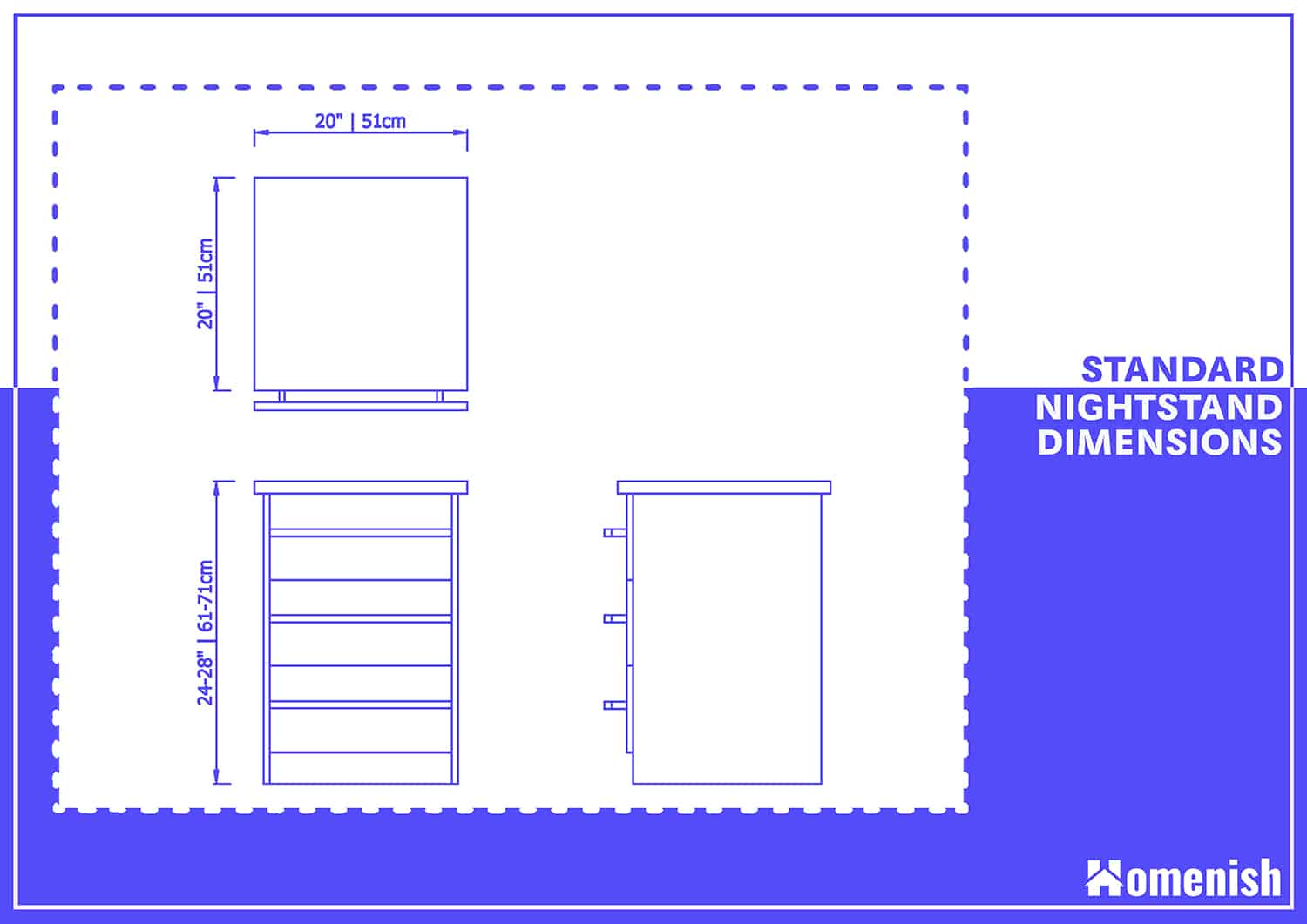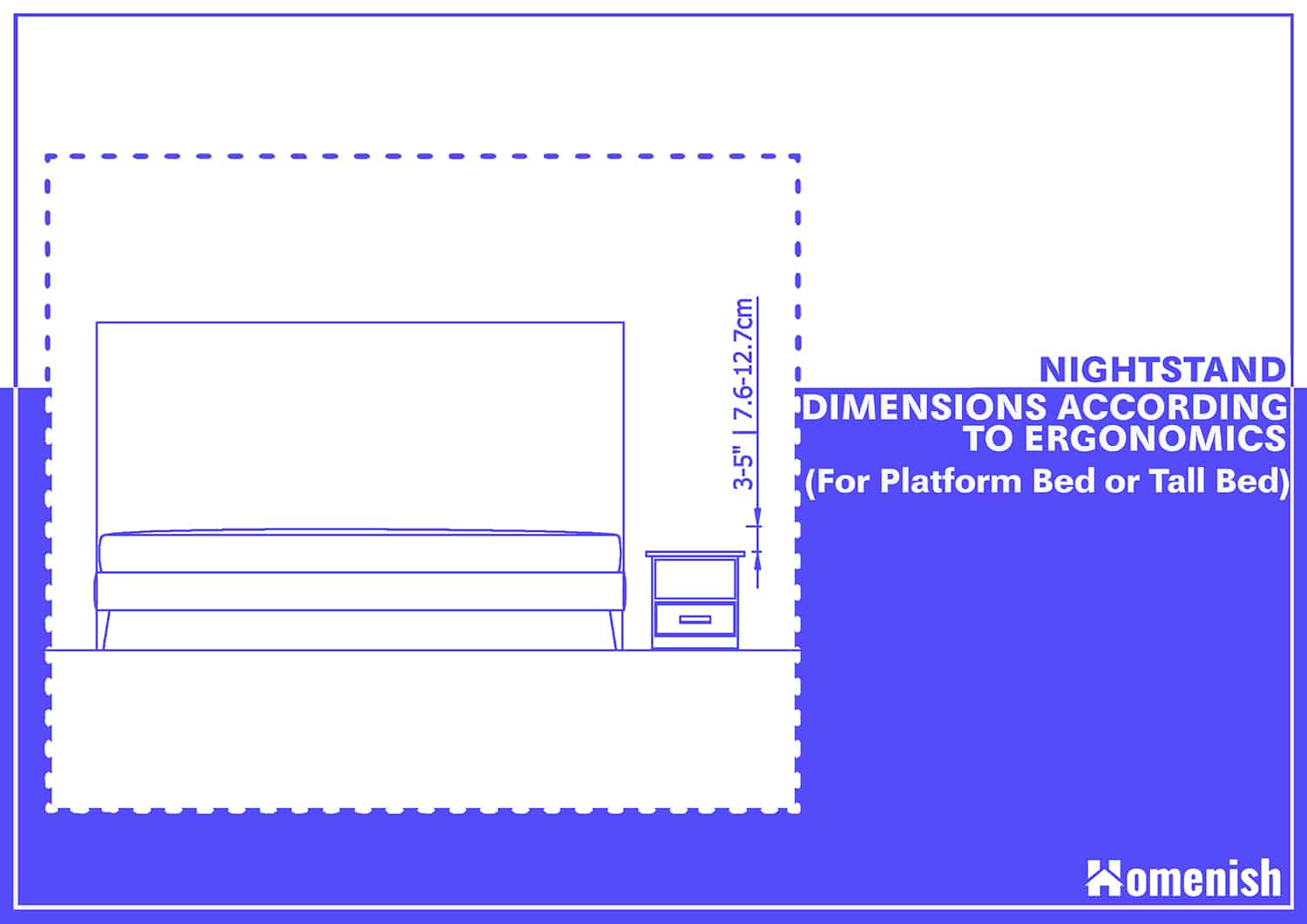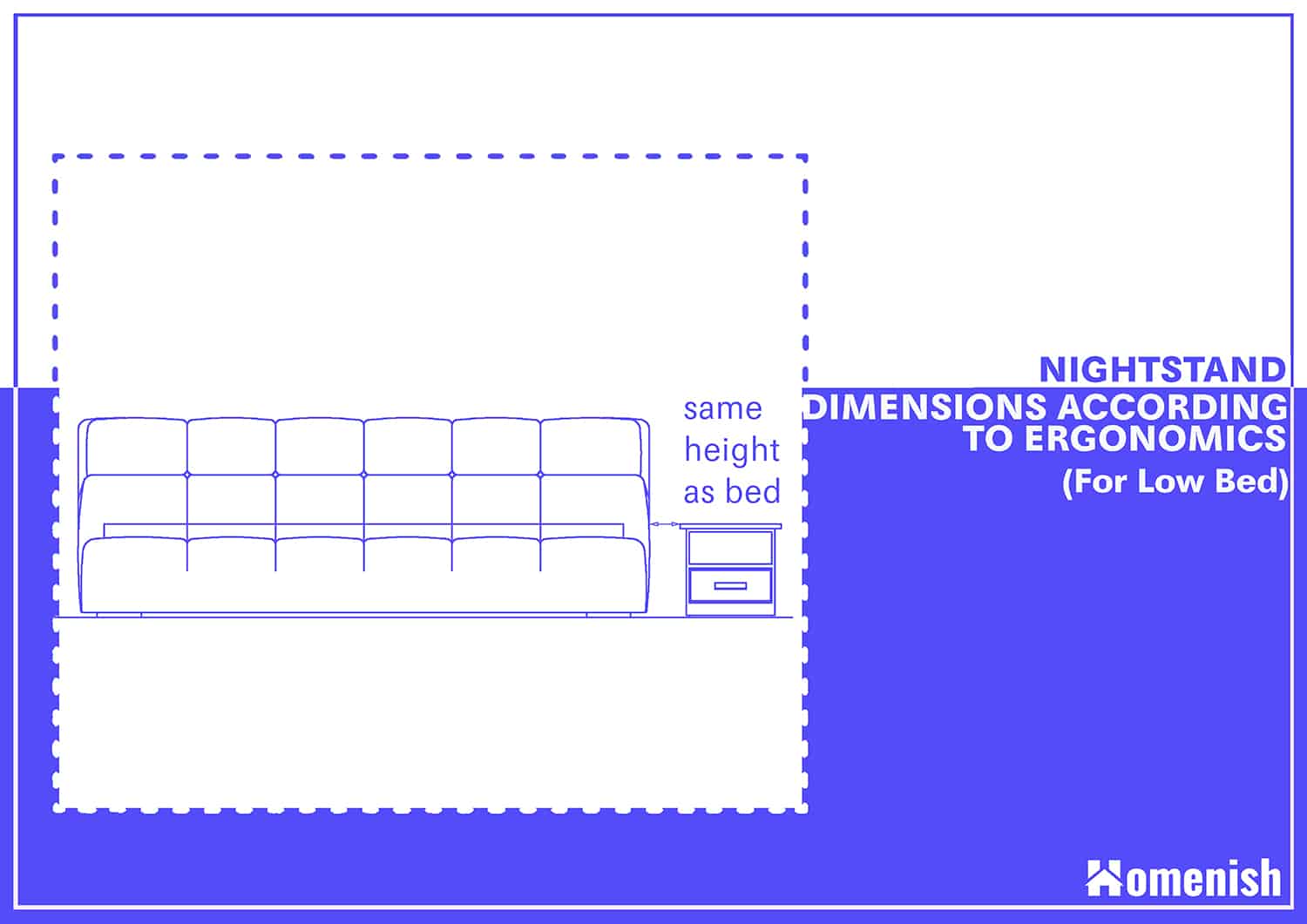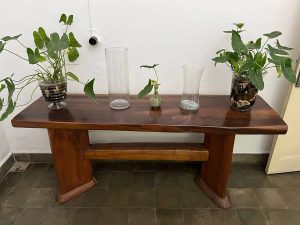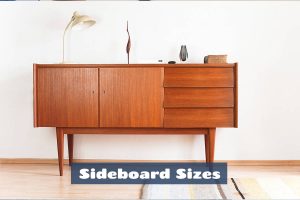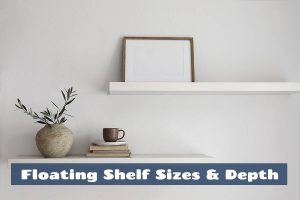It doesn’t matter how thirsty or sweaty you feel; very few of us enjoy having to get up after we have already tucked ourselves in for the night. Because of this, any properly outfitted bedroom should include a place to hold your glasses, smartphone, A/C remote, bottle of water, and a small reading light.
A bedside chest or nightstand perfectly fits these requirements, being compact enough to fit beside most beds while offering just enough surface space to make them functional. Here we explore different types of nightstands and their dimensions.
What Exactly Is a Nightstand?
Few pieces of furniture come with their mini-dictionary of names as nightstands do. If you couldn’t immediately associate this word with a piece of furniture you need, then keep in mind that some parts of the U.S. refer to them as:
- Night tables
- Bedside tables
- Bedroom end tables
- Bedside drawer
Either way, we are talking about a small table, which may include a small drawer or shelf, which is usually placed on one or both sides of a bed.
If you are fond of repurposing old furniture or scouting for vintage pieces, keep in mind that some stool models, as well as most small cupboards and coffee tables, can all take the place of a nightstand.
Standard Nightstand Dimensions
The exact size of a nightstand varies greatly depending on the brand and the manufacturer. Unlike beds, where standardization gives us a set of predetermined sizes (and all with easily recognizable names, too), there are no standard nightstand sizes.
That being said, the overwhelming majority of ready-to-use nightstands tend to follow very similar sizing patterns.
Standard nightstands are between 24 and 28 inches in height, as this is meant to match the height of most bed models. As for the table itself, expect most square nightstands or bedside chests that feature drawers to be close to 20 inches by 20 inches.
If you are opting for a “stool-like” model rather than the more popular square table and drawer, you will probably get a round tabletop. Most round nightstands will then have a diameter between 17 and 20 inches.
Floating Nightstand Dimensions
A floating nightstand is essentially a shelf fixed to the wall beside your bed, at the typical height of a nightstand. This creates a surface space for storing your book, your cell phone, or a drink without taking up any floor space. Floating nightstands work really well in small bedrooms because they create a more airy feeling which allows the space to feel bigger.
Floating nightstands are also a great choice for modern or minimalist styles, and they are ideal if you are on a budget because they are typically more affordable than typical bedside chest furniture.
Floating nightstand dimensions can be customized to your preferences, but generally, they will have a width of around 12 to 24 inches and a depth of 12 inches. They should be fixed to the wall at a height appropriate for your bed, which is usually around 22 inches from floor level.
Common Nightstand Brands with Their Dimensions
Hemnes Nightstand Dimensions
The IKEA one-drawer HEMNES nightstand dimensions are 18 inches in width, 14 inches in depth, and 27.5 inches in height. This is a great nightstand for small spaces, and there is a wide range of matching bedroom furniture if you want a coordinated look.
Malm Nightstand Dimensions
The IKEA MALM nightstand dimensions are marginally bigger than the HEMNES nightstand dimensions, with a width of 16 inches, a depth of 19 inches, and a height of 22 inches. The MALM nightstand with two drawers offers more storage than the HEMNES nightstand, but it has a lower height which makes it better suited to low-depth bed frames.
How to Choose Nightstand Size
There are three main factors to consider when choosing a nightstand. The first (and probably the only hard limit you have) is that you want something that fits inside your room.
However, you will also want to look at your comfort and at the overall esthetic impression they produce. When choosing a bedside table or nightstand, your main priority should be to ensure everything you need is at hand, so the height of the table and proximity to the bed is important.
Nightstand dimensions according to room size
If you are dealing with a very small bedroom it is easy to fall into the “fear of the void” mistake, where you try to make the most of every available inch by filling it with furniture. This is something that is best avoided, especially when it comes to sleeping spaces because it will create a sense of chaos where a calm and soothing atmosphere is much more appropriate. Bear this in mind when choosing your nightstand, and ensure that you have some clearance around it.
Ideally, you should have an inch of space between the back of the nightstand and the wall behind it. This will let you pass the cabling for any small lamps or your cellphone charger.
While you want to be able to reach everything on your nightstand without leaving the bed, you should still leave at least two inches of space between the bedside chest and the bed so it doesn’t look cramped. If you have more space to work with, you can opt for a larger nightstand or even use a bedroom dresser as a nightstand, but be careful not to have too much bedroom furniture in a bedroom.
Nightstand dimensions according to ergonomics
Ergonomics refers to your bodily comfort when using a specific object, and when choosing the size of a nightstand this is something you should give consideration to.
What you really want to avoid here is having the top of your nightstand higher than the top of your bed. This may make it uncomfortable to reach any objects at night.
If you have a platform bed or a tall four-poster bed, then try to ensure your nightstand is between 3 to 5 inches shorter than the top of your bed. This will let you grab anything quickly, but it won’t be too low that you would have to bend over if you are standing up.
If you have a low bed model, such as a spring box, then aim to keep both your nightstand and bed at the same height.
Nightstand dimensions according to room décor
When you are judging the esthetic appeal of a bedroom, you want to make sure that the “set” created by the bed, the nightstand, and any nearby cabinets are pleasing and well-balanced.
If you have a Queen or King-sized bed, you will most likely want to have two nightstands, one on each side of the bed. In such cases, your best bet at a harmonious look will be to aim for symmetry.
When attempting to do this, follow the rule of thirds: try to keep the total width of both nightstands to be about a third of the total width of the mattress.
In the case of twin beds, you will probably only need one nightstand (and you may even have a wall or window on the other side of the bed). Here, the goal will be to ensure that the furniture doesn’t look too cramped.
Ideally, a wooden bed or headboard should be of the same style or color as the nightstand. This is easier to achieve if they came in as a set. If you have an end-of-bed storage bench, you can try to match the nightstand to it rather than the bed.
If the bed or nightstand is of dark-colored wood, then aim for a smaller nightstand. The extra space will help the room look bigger.
Final Thoughts
When choosing a bedside table or nightstand, your main priority should be to ensure everything you need is at hand. Ultimately, when the light goes off, nobody wants to be left scrambling for their reading glasses!
